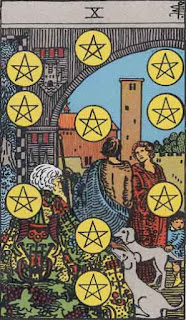Welcome to the First Lesson of Tarot
Before we proceed, there are a few initial tasks you should complete:
- Acquire a tarot deck, preferably the Rider-Waite system, which will be the focus of our discussions.
- Unwrap the deck and take a moment to familiarize yourself with the cards.
- Read through the accompanying booklet for a brief overview.
Once you have finished these preliminary steps, you are ready to embark on your tarot journey.
At first glance, tarot may seem overwhelming due to the various meanings assigned to each card, intricate imagery, and existing assumptions. However, the beauty of tarot lies in its closed system of interpretation, with only a few exceptions to the general rules that govern card meanings. Additionally, tarot is a subjective practice, allowing your personal experiences, meanings, and interpretations to shape your unique tarot journey.
Now, let's begin by exploring the structure of tarot.
A key aspect is the Major Arcana, consisting of 22 cards that range from The Fool (0) to The World (XXI). These cards, known as trumps, hold significant influence within the deck. When a major arcana card appears in a reading, it takes precedence over other cards and determines the overall interpretation. Each major arcana card represents a major archetype. For example, The Emperor (IV) embodies the father archetype, emphasizing values of order, obedience, and inner and outer strength.
To deepen your understanding, take some time to complete the following homework:
- Examine each major arcana card, noting its traditional meaning, your personal affinity or aversion towards it, any associations it evokes (such as people, places, or ideas), or even envision a theme song for the card.
- Consider how the person depicted in the card would handle minor inconveniences.
This process may vary in duration, so proceed at your own pace. In our next lesson, we will look deeper into these cards. For now, let's move on to gain a broader perspective.
Now, let's explore the Minor Arcana, which consists of the remaining 56 cards that represent the everyday aspects of life. The minor arcana can be best understood by examining their division into suits and types.
The four suits (swords, wands, cups, and pentacles) are similar to a standard deck of cards. Each suit directs attention towards different facets of our lives, collectively offering insights into the multifaceted nature of being human. When interpreting tarot readings, it is crucial to consider the suit of the cards on the table. Let's briefly explore the suits and their associations, reserving a deeper exploration for future discussions.
Swords, associated with the element of air, pertain to knowledge, wisdom, communication, and travel. When reading swords, contemplate how you engage with information, your theories about yourself and others, and how you express thoughts and receive input. These cards may reveal darker aspects but reflect the inherent complexity of knowledge.
Wands, representing the element of fire, embody creativity, passion, and innovation. They capture the fervent yearning for distant adventures (II), the joyous celebrations with loved ones (IV), and the defense of personal choices and values (VII).
Cups, associated with the element of water, reflect the emotional and intuitive aspects of our lives. They explore our relationships, the love and empathy we extend to others, our dreams and aspirations, and the ebb and flow of our emotions.
Pentacles, connected to the element of earth, represent the material and practical aspects of life. They focus on our physical world, encompassing our work, finances, health, and resources. Pentacles remind us to ground ourselves in the tangible, focusing on the external manifestations of our endeavors.
The minor arcana also encompasses numbered cards (Ace to 10) and court cards. The numbered cards illustrate the progression of each suit, reflecting the journey from the initial stages to eventual mastery. For instance, the Ace of Pentacles heralds new opportunities and potential, while the Ten of Pentacles signifies abundance and fulfillment.
Court cards, on the other hand, depict people and can be interpreted in various ways. The traditional approach assigns specific personality traits and roles to each court card. Pages represent beginners or learners, Knights embody communicators and travelers, Queens nurture and provide support, and Kings assume leadership roles, bringing order and direction.
However, alternate interpretations for court cards exist. Some practitioners treat them as regular numbered cards, while others consider them as minor archetypes or agents of karma. Feel free to explore these alternatives and select an approach that resonates with you.
These frameworks offer a foundation for your tarot studies, allowing you to become better acquainted with your tarot deck. However, please remember that we have only begun to scratch the surface. There is an abundance of wisdom and insights awaiting us in our forthcoming lessons.
Thank you for investing your time in this lesson, and stay tuned for the upcoming sessions!
-Tomlin











Comments
Post a Comment